Tapes and trimmings used in construction
Bias tapes are fabric strips of varying widths, with prefolded edges. Suitable for curved hems, or as a casing. Double-fold type is folded in half (off center) for quick use as binding.
Hem facing is a wide, flexible tape cut to the width (approximately 2 inches) most often used for the job. Available in a bias strip with edges prefolded to the inside and in a more decorative lace construction. These prepackaged hem facings are useful when there is insufficient hem depth for a turned-up hem in a garment or a wish to eliminate bulk in a hem made from a heavy fabric. Bias hem facings can also be used as a wide casing or pressed in half for use as a binding. Both bias and lace types are available in an assortment of colors.
Twill tape is a woven stable tape used mainly for staying and strengthening seams, especially in tailoring. Usually made of cotton, twill tape comes in black and white, in widths of ¼, ½, ¾, and 1 inch.
Grosgrain ribbon is both a practical and a decorative trim; its stability makes it ideal for finishing or staying a waistline. For firmer support, a slightly heavier, more rigid type is also available. Ribbons come in various colors and widths.
Fold-over braid, too, is decorative as well as utilitarian. Both edges are finished; braid is folded in half, slightly off center, for easy application when binding or trimming an edge. Avail able in various colors and designs, usually by the yard.
Horsehair braid, a stiffening made from transparent nylon strands, is used to finish the bottom of hems so as to emphasize the flare of the skirt; most often found on long evening wear. Available in ½ and 1 inch widths; wider braid may have a pre-sewed ease thread along one edge.
Horsehair braid
Cable cord, which resembles string or twine, is usually made of cotton and can be used wherever a cordlike filler is needed, as in cording or corded buttonholes. Can also be inserted into bias tubing and used as a drawstring. It is usually sold by the yard in thicknesses ranging from approximately __ to 1 inch.
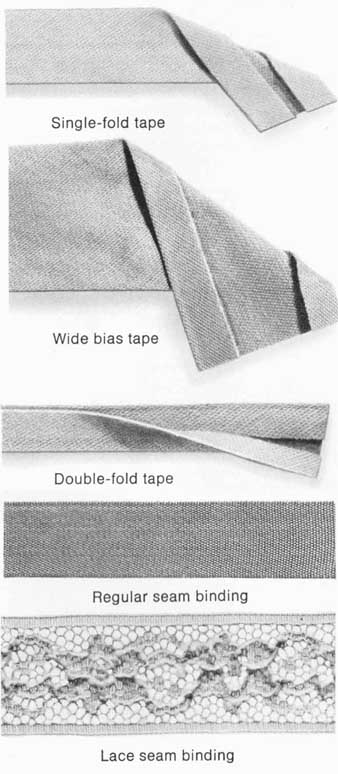
Narrow cable cord:
Cording is a pre-corded decorative seam insertion used on garments or home decorating items, such as bed spreads. One edge is welted; the other acts as a small seam allowance. The most common type is made with a bias strip wrapped around cable cord. Welt sizes and colors are limited.
Cording Single-fold tape---Twill tape Wide bias tape Double-told tape Seam binding, a straight tape used for finishing hem edges, comes in woven or lace form. Woven type is stable, and can also be used to stay seams. Lace has stretch, is ideal for knits.
Regular hen facing Groagrain ribbon---Wide cable cord Lace seam binding Lace hem facing Fold-over braid
Ribbings are knitted, stretchy, decorative bands that are available in various widths and designs. The narrower ribbings are used as a quick finish and color accent for neck and wrist edges; the wider ones, as waist line insets or edgings. Some ribbings have small seam allowances constructed within the band to simplify application. Ribbings vary in amount of stretch; be sure that the stretch of the ribbing you wish to use is suitable to garment's need. Ribbings come in packaged quantities or by the yard.
Waistband stiffenings give rigid stability to waistlines; select one to
suit need. Belting, a cardboardlike band, is the most frequently used insert
for belts and waistbands; professional waist banding, a non-roll, heat-set
stiffener, can be used in place of interfacing; men's waist banding, a pre
assembled waistband, finishes t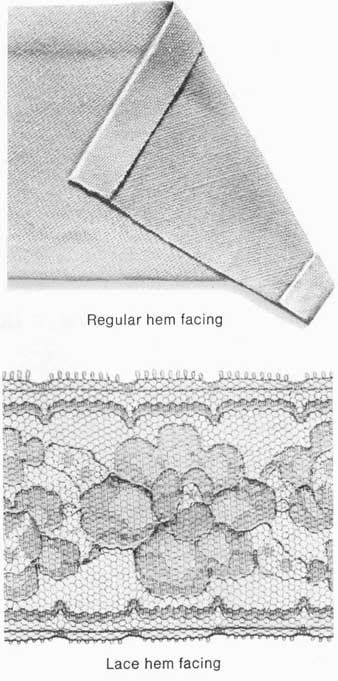 he in side of men's trousers.
he in side of men's trousers.
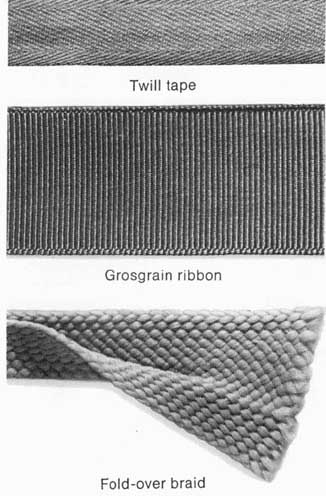
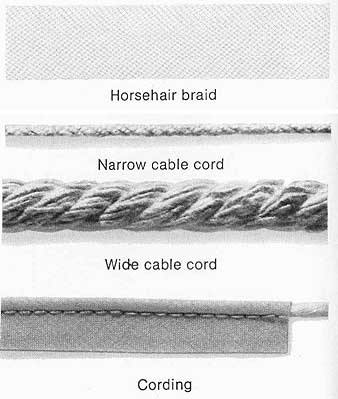
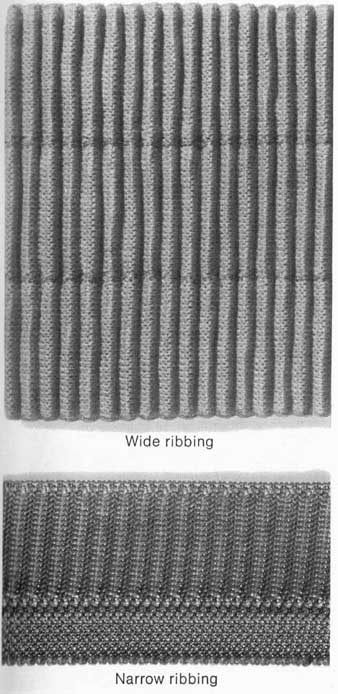
Elastics:
Most elastics are made from a rubber-core yarn covered with cotton, synthetic, or a blend of fibers. They may occur as a single yarn or as several yarns braided, woven, or knitted together. Single-yarn elastics can be used for hat bands, loop closings, or as elastic thread for shirring. Braided elastics can be identified by the length wise, parallel ridges that give these elastics a strong "grip." Because of its structure, braid narrows when stretched, and is recommended for casings rather than for stitching directly to a garment. Woven and knitted elastics are usually softer than braided elastics; their constructions enable them to maintain their original width when stretched. Woven and knitted 'elastics curl less than braided elastics and so can easily be stitched directly to a garment.
When selecting elastic, note that elastics are made and sold for special purposes, such as pajamas, lingerie, bra closures, etc. If a particular type cannot be found, look for an elastic with the features most suitable to the style and use of the garment. Consider construction (i.e., woven or braided), width, fiber content (especially important in swimwear-rayon stretches when wet), gripping power, weight compatibility. Look, too, for new elastic products, such as wide, colorful elastics that can serve as waistbands for skirts or pants. For best results, always use a ball-point sewing machine needle when sewing on the elastics.
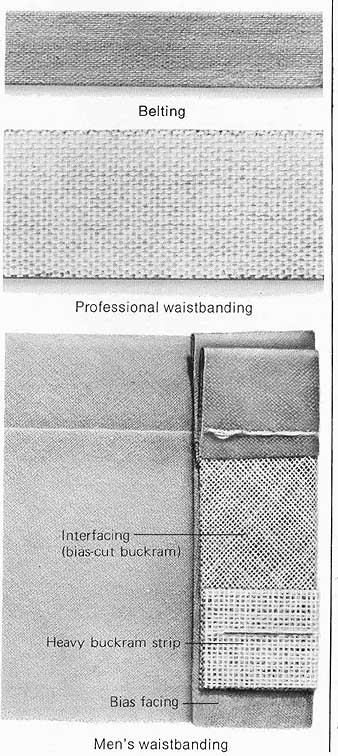
Iron-ons and fusibles:
Iron-ons are adhesive-backed fabrics that are pressed onto the garment fabric rather than stitched. They can be found in different forms and are used for different purposes. Some are available as interfacings (both non-woven and woven types); these are usually sold by the yard. Others come in the form of strips or patches for mending, repairing, or adding strength to such stress areas as knees or elbows. Some patch iron-ons are intended to be decorative; can serve as appliqués. Mending strips and patches are produced in precut lengths and/or shapes in a variety of fabrics, such as corduroy, twill, denim, knit, and muslin. Precut printed or embroidered designs are available for use as appliqués, or one can be cut from a plain strip or patch.
Iron-ons are recommended for use on fabrics that can withstand high iron temperatures (some require steam), but read package instructions and precautions. Pretest if possible.
There are also weblike bonding agents which, when melted between two layers of fabric, join them together. Used properly, they will hold a hem, facing, trim, or appliqué to a garment with no hand sewing. Fusing webs can also function as a light weight interfacing between the garment and facing. These webs are not intended to form seams.
Fusing webs are sold by the yard, but they also come in packaged pre cut lengths and widths designed for specific areas, such as hems. They are recommended for all types of fabrics that can be steam pressed except sheers and a few synthetics. Check package instructions for recommendations, and be Sure to pretest on a fabric scrap. Follow instructions care fully when applying web.
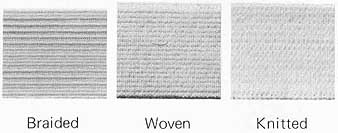
Braided—Woven—Knitted: Professional waist-banding Narrow ribbing; Men's waist-banding
Sewing equipment
Pressing conveniences
Pressing is important at all stages of sewing to shape and set stitched lines. Steam iron and ironing board are essentials; the pieces of equipment shown here are useful additions. In any pressing procedure, follow these sound practices: (1) Press each stitched seam before crossing with another.
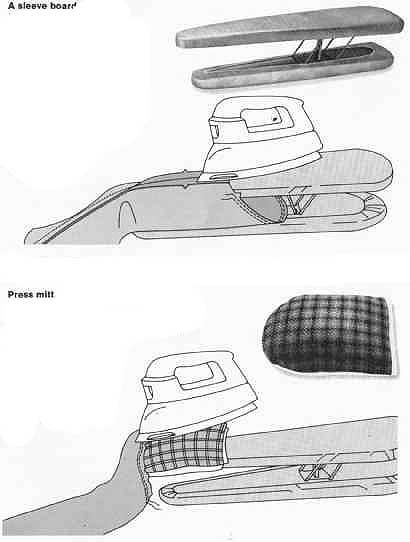
First press over seamline (to embed stitches), then press open. (2) Use press cloth to prevent iron shine; dampen to produce more steam if needed.
(3) Press with a gentle up-and-down motion. (4) Avoid pressing over pins and bastings. (5) To finger-press, run thumb along opened seamline.
-- A sleeve board provides two small, flat ironing surfaces on which seams and details of narrow garment sections (e.g., sleeves, pants legs) can be easily pressed. Also helpful when pressing hard-to-reach areas, such as necklines and sleeve caps. Below, sleeve is slipped over board, making its long seam easily accessible to the iron.
Press mitt, a padded glovelike cushion, is used as pressing surface for small garment areas; is especially handy where tailor's ham cannot reach. Comes with wool on one bide, cotton on other, with pockets for slipping over hand. Mitt can also be used over sleeve board as shown below; provides rounded surface for molding sleeve cap.
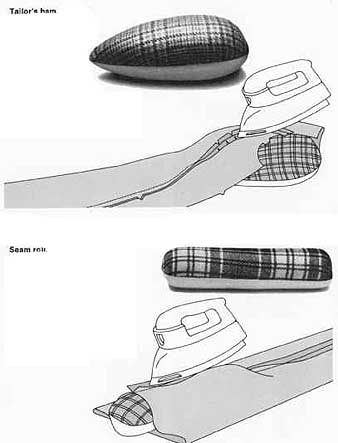
Seam roll, a firmly packed cylindrical cushion, is used primarily for pressing seams in very narrow areas, such as sleeves. As shown below, roll also allows seam td be pressed open with no marring of the surrounding fabric; bulk of garment falls away as seam of pants leg is pressed. Like the ham, roll is covered with wool on one side, cotton on the other.
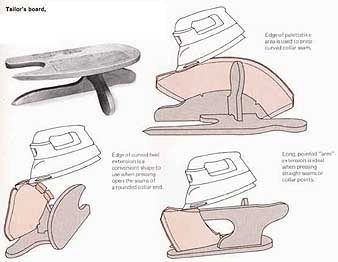

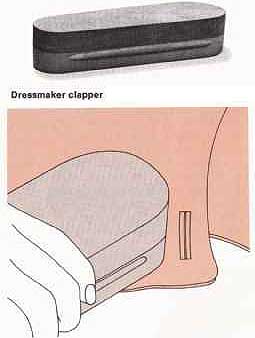
Tailor's ham, a firmly packed cushion, has rounded surfaces for pressing shaped areas, such as bust darts ' and curved seams. Below, princess line curve is molded as seam is pressed open. Covering is wool on one side, which holds steam as woolens are pressed; cotton on other for pressing all fabrics, especially at high temperatures.
---
Tailor's board, a pressing tool made of hardwood, has a number of differently shaped edges and surfaces for pressing flat garment areas as well as points and straight and curved seams. Padded cover for board is available when soft edge in garment is desired.
Edge of palettelike area is used to press curved collar seam.
Long, pointed "arm" extension is ideal when pressing straight seams or collar points.
Edge of curved heel extension is a convenient shape to use when pressing open the seams of a rounded collar end.
--
Velvet or needle board, a pressing surface for pile fabrics, consists of steel wires mounted on heavy canvas. When fabric is placed face down on the board, wires fit between pile, keeping it from matting during pressing.
- Dressmaker clapper is a rounded wooden block used to obtain sharp creases in heavy fabric; it is especially useful in tailoring. Bulky edge of the garment is first pressed with steam iron, then pounded with clapper. Pounding helps to speed the removal of steam from the fabric. Use of the clapper helps fabric to hold its crease when dried.
- Point presser and pounding block is a wooden tool with a dual purpose: the straight point surface is used when pressing corners, points, and straight seams (see tailor's board); the block base works in the same way as the dressmaker clapper.
